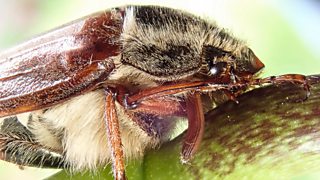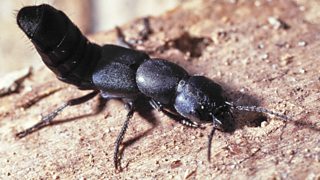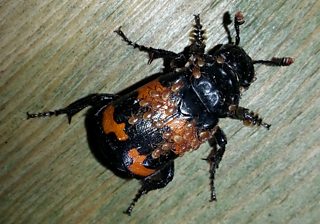By Steve Garland, chair of Lancashire Wildlife Trust, and beetle expert, enthuses about these incredible insects.

Cockchafer by Steve Garland
One in five of all known species on earth is a beetle – that’s over 400,000 different species! They range in size from the 16cm-long Amazonian titan beetle to the tiny feather-winged beetles, which measure 0.2mm! Around 4,000 species are known in the UK and they are a key part of our ecosystems, with both adults and larvae doing many different jobs.
I was an insect enthusiast from an early age, and fascinated by the faint, blue glow in our garden, which proved to be a female glow-worm beetle shining to attract a mate. Then there were the cockchafer beetles (Melolontha melolontha). These hefty ‘monsters’ crashed into our porch-light after dark and were collected into a jar to impress my friends (but not my mother) the next morning.
Pollinators
Beetles occupy all sorts of niches and perform many important jobs. Rose chafers are important pollinators of wild rose and the flowers of hogweed and cow-parsley can be covered with red and black soldier-beetles (Rhagonycha fulva). However, many important pollinator beetles such as pollen and flower beetles are tiny, so you will have to look very closely to spot them.
Predators

iBroadcast image Devil s coach horse by Steve Garland
If you look under a log or stone you may find ground beetles or a Devil’s Coach-horse (Ocypus olens). They hide there during the day and come out at night to hunt for prey, when you can find them if you search with a torch.
Ladybirds are important predators of greenfly, helping keep them in check, and ground beetles eat huge numbers of invertebrates that like to feed on our crops and gardens plants.
The most impressive are tiger beetles (Cicindela), which fly and run about in hot, sunny spots at an amazing speed. Their scimitar-shaped jaws are a formidable weapon for catching and eating other insects.

Tiger beetle by Steve Garland
Grazers
Many eat plants, especially the leaves and seeds. Green dock beetle larvae (Gastrophysa viridula) can be found in large numbers on dock plants, skeletonising the leaves and helping control the plant. The red of the lily beetle adds a splash of colour amongst the green, and I know a lady who thinks their beauty adds to her garden experience and is worth a few nibbled lilies!
Recyclers

Sexton beetle by Steve Garland
Sexton beetles (Nicrophorus) smell out dead animals and dig beneath them to lay their eggs, slowly burying them, hence their alternative name of burying beetles. These beetles really stink, a result of their putrefying diet!
Beetles also recycle dung, dead wood and dead bodies. Dor beetles (Geotrupes) bury animal dung and lay their eggs on it. This helps get nutrients into the soil and gets rid of cow pats! In Australia, native dung beetles ignored the dung of imported cattle, so dung beetles from other countries were introduced and now help process over 30 million tonnes of cow-pats every year.
Beetles as food
Beetles also form a major food source for many birds and mammals. Wading birds and starlings probe fields for cockchafer grubs living in the soil, whilst noctule bats get an important boost when the nocturnal adults emerge in May. Beetles are also a favourite food of hedgehogs.
To survive, many are camouflaged to hide on leaves or bark, others are toxic and brightly coloured as a warning. Many fly or jump to escape and a few, such as the aquatic screech beetle (Hygrobia hermanni), can make a disconcerting hiss when caught. None can compete with the aptly-named bombardier beetle (Brachinus crepitans) which ejects chemicals from a pair of glands on its rear which mix, react and turn into boiling hot irritant steam, enough to make any predator spit it out!
Bizarre beetles

Oil beetle by Steve Garland
The oil beetle (Meloe) exudes toxic oily fluid from its leg joints if threatened. It has an amazing life history; the female lays her eggs in soil and the tiny larvae climb up onto flowers. There they wait for a solitary bee to visit, then climb on-board and hitch a ride back to the bee’s burrow where they feed on provisions that the bee provides for its own grub – like an insect version of the cuckoo. The wasp-nest beetle (Metoecus paradoxus) does the same to wasps, laying eggs on bare wood so its larvae can climb onto wasps as they chew the wood to build their nests, gaining them entry to the wasp-nest. You may find dead ones in your attic if you have had a wasp nest in your roof.
Beetle conservation
Unfortunately, many are under threat. Loss of wild habitats is having a big impact, as is the wider use of ever-more-toxic pesticides. Like all insects, they are an excellent indicator of the health of our world, and their decline is a warning.
Dung beetles, once widespread, have disappeared from some areas. Cattle kept indoors provide no cow-pats for dung-beetle food, and the liquid slurry sprayed over pasture is of little use to them. Many farm animals are given anti-worm treatments that pass through and kill beetle larvae in the dung. We want future generations to have a chance to watch male stag beetles locking horns in a trial of strength, and gasp at the jewel-green rose chafer as it pollinates a pink dog rose.
Bring back our beetles
This year The Wildlife Trusts and the RHS are encouraging people to help beetles, the unsung heroes of the garden.
Make a dead hedge – Structured piles of branches and twigs can be used to divide up an area of the garden and provide a residence for beetles as they rot away
Build a beetle bank – Adding a mound of soil, particularly in flat gardens, adds both shady and sunny habitat and provides shelter for lots of invertebrates
Create a beetle bucket – perfect for small gardens, filling a bucket with rotting wood and leaves makes a home for all sorts of beetles and other insects
